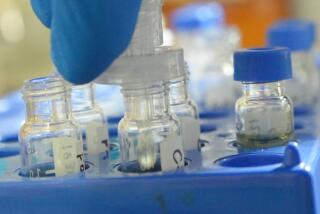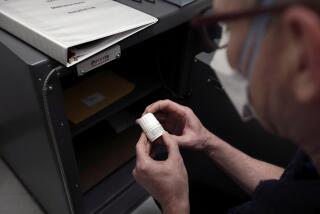Effectiveness of Drug Testing in Workplace Questioned : Health: Report cites flaws in efforts to solve society’s narcotics, alcohol problems. Advocates of corporate involvement challenge the findings.
- Share via
WASHINGTON — Only limited scientific evidence exists showing that employer programs to combat alcohol and drug abuse are effective, a panel of research and medical experts said in a report released Monday that questioned the more than $1 billion being spent annually on such efforts.
“Workplace-oriented interventions cannot solve society’s problems with alcohol and other drugs,” said the report by a committee from the National Research Council and the Institute of Medicine. The findings, however, were immediately challenged by advocates of corporate involvement in efforts to fight drug and alcohol problems.
The report noted that nearly $1.2 billion is being spent annually on workplace drug-testing programs alone. The committee cited a lack of thorough research into the relationship between drug-testing programs and worker productivity. Studies that have been done often suffer from significant flaws, the report said.
The report raised special concerns about pre-employment drug testing, noting that job applicants have none of the safeguards that employees enjoy in dealing with the serious consequences of the test results.
“If a positive test result is reported by the laboratory, the applicant should be properly informed and should have an opportunity to challenge such results,” the report recommended. That opportunity should include “access to a medical review officer or other qualified individual to assist in the interpretation of positive results before the information is given to those who will make the hiring decision.”
The committee was formed in 1991 by the Commission on Behavioral and Social Sciences and Education of the National Research Council and the Division of Health Promotion and Disease Prevention of the Institute of Medicine. The council, principal operating arm of the National Academy of Sciences and the National Academy of Engineering, provides science and technology advice under a congressional charter, as the Institute of Medicine does on health policy.
With its work funded by the National Institute on Drug Abuse, the committee’s mission was to analyze scientific knowledge on the prevalence and cause of drug consumption by the U.S. work force, its impact on work performance and the effectiveness of work site prevention and treatment programs.
The study is likely to generate controversy because the Clinton Administration, as did the George Bush and Ronald Reagan administrations before it, puts great emphasis on attacking alcohol and drug abuse through the workplace.
Atty. Gen. Janet Reno and Lee P. Brown, director of the White House office of national drug control policy, had not yet received the report Monday, their offices said. But Brown, in an interview, underscored the value he places on anti-drug programs in the workplace. He said such efforts improve worker safety and health, reduce sick time and enhance productivity, making the nation more competitive.
Reno, in a speech last May to the Institute for a Drug Free Workplace, made clear her support. “I think corporate and business Americans have in many respects taken the lead in initiatives that I think have a long-range impact on drug abuse in America,” she said.
Mark A. deBernardo, executive director of the Drug Free Workplace Institute, contended that the report is misleading. “A lot of these conclusions taken out of context will prove useful to opponents of drug testing,” he said.
He joined Thomas Hedrick, president of the New York-based Partnership for a Drug-Free America, in arguing that if workplace programs did not work, profit-minded corporations would drop them.
Hedrick said he is “not at all surprised” by the report’s conclusion that there is little hard evidence about the effectiveness of such programs. He said the major reason has been the confidentiality of private sector companies, which either do not want to be seen as part of the drug problem or decline to share information on workers.
The report cited 1990 estimates that approximately 7% of American workers had used an illicit drug in the month before being surveyed, down substantially from the 14% of the general population found to have used one or more illicit drugs in 1979.
“Clearly, workers entering the work force in the 1990s are likely to have substantially less experience with illicit drugs than did their counterparts in the 1980s and late 1970s,” the committee said. “However, given these long-term trends, caution must be used in attributing these changes in drug use to specific intervention programs.”
Drug tests, usually by urinalysis, have limited ability to assess either drug abuse or dependence, the report said. Abuse was defined as drug use that leads to adverse physical or psychological consequences, while dependence is drug use with significant adverse physical and psychological consequences, including impairment of the individual’s ability to function and a compulsive desire to use a drug repeatedly.
The committee found that employee assistance programs have focused their energies on finding new cases of drug or alcohol abuse, devoting little time to preventing relapses.
“Employment assistant programs may not be preventing relapses as much as they are teaching clients how to use the treatment system more frequently,” the report said.
More to Read
Sign up for Essential California
The most important California stories and recommendations in your inbox every morning.
You may occasionally receive promotional content from the Los Angeles Times.










